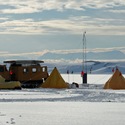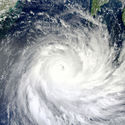How much water flows in the Antarctic Circumpolar Current? Scientists undetook a research voyage to find the answer.
Voyage leader, Dr Mike Williams of the National Institute of Water and Atmospheric Research (NIWA), worked with scientists from Australia and New Zealand to find the answer to this important question.
The Antarctic Circumpolar Current is the largest current in the world. ‘It’s been estimated that this current is 110–150 times larger than all the water flowing in all the rivers of the world,’ says Dr Mike Williams. He also adds that,
In terms of the world’s oceans, New Zealand is not some tiny backwater, or the proverbial last bus stop on the planet — we are right beside the motorway.
Dr Mike Williams
The Antarctic Circumpolar Current travels clockwise around Antarctica. It is a vital link in the global ocean conveyor, connecting the waters of the Atlantic, Indian and Pacific Oceans. And scientists want to know exactly how much water flows past New Zealand. This vital information will be important for understanding how the current affects our climate.
They measured the current by deploying nine strings of current meters in two gaps in the Macquarie Ridge, which runs southwest of New Zealand past Macquarie Island and left them collect data for a year, as currents vary through the seasons so at least a year’s worth of data needed to collected. One of the findings was discovering that the speed of the current passing through the Macquarie Ridge is about 4 km per hour.
The team also systematically measured the temperature and salinity of this part of the ocean for the first time since the 1960s, looking for any climate-related changes, and collected water samples to measure nutrients available for marine life.
After the data was analysed in 2008, it was worked out that it is likely that the Antarctic Circumpolar Current transports 110–150 million cubic metres of water per second, (by comparison, all the water flowing out of all the world’s rivers is about a million cubic metres per second). Further global research is ongoing.
Related content
Find out more about the Antarctic Circumpolar Current in this article looking at the Currents in the Southern Ocean and Ocean motion.
In the Saline currents activity students observe how freshwater and saltwater mix.
Useful links
In 2008, New Zealand Science, Mathematics and Technology Teacher Fellow, Jenny Pollock wrote an article Linking the world’s oceans: the Antarctic Circumpolar Current.
See Explainer: how the Antarctic Circumpolar Current helps keep Antarctica frozen, from The Conversation.
Donohue, K.A., Watts, D. R., Chidichimo, M.P., Chereskin, T. K., Mean Antarctic Circumpolar Current transport measured in Drake Passage. Geophysical Research Letters, (2016) Vol 43, Issue 22. https://doi.org/10.1002/2016GL070319




